From the State’s point of view, it is pertinent to compare the return on investments with the cost of net government debt, because the funds accumulated in preparation for future pension expenditure can be deemed to reduce such debt. Over the past ten years, VER’s average annual rate of return has beaten the cost of net government debt by 5.8 percentage points. Since 2001, the total market-value returns earned by VER have exceeded the cumulative average cost of equivalent government debt by about EUR 10.2 billion over the same period.
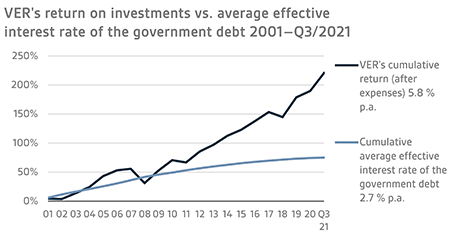
VER monitors long-term return relative to overall market developments by comparing the actual return with a global index, in which the weight of both equities and currency-hedged bonds is 50 per cent.
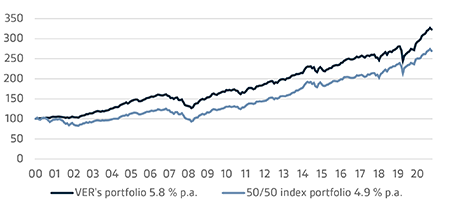
A CLOSER LOOK AT JANUARY–SEPTEMBER 2021
In accordance with the directive of the Ministry of Finance, VER’s investments are divided into fixed income instruments, equities and other investments. At the end of September, fixed income instruments accounted for 36.3 per cent, equities 47.8 per cent and other investments 11.2 per cent of the total. Of the large asset classes, liquid fixed income instruments generated a return of 0.9 per cent and listed equities 16.7 per cent during the first half of the year.
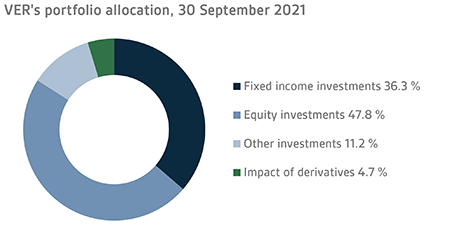
FIXED INCOME INVESTMENTS
Liquid fixed income investment
During the first three quarters of the year, the return on liquid fixed income instruments was 0.9 per cent.
With the improvement in the Covid-19 vaccine coverage and increase in inflationary pressure, the focus in the fixed income market shifted to the post-pandemic period. At the same time, central banks started a debate on, and partly adopted, a number of measures to gradually tighten the monetary policy with a view to a return to more normal times. As a result, there was a sharp rise in interest rates in September.
Especially in the United States, the plan is to cut down on asset purchases at a fairly quick pace, and the first interest rate hike is expected already at the end of 2022. A positive trend in employment and economic growth and, above all, the accelerating inflation and growing inflationary expectations call for a normalization of monetary policy. While the extremely high inflation figures for 2021 are seen as temporary, the US core inflation is predicted to remain above 2 per cent for the next few years.
Similarly, the European Central Bank (ECB) started normalising its monetary policy in September by scaling down purchases under the PEPP programme that had been temporarily increased. Although the ECB will likely stop PEPP asset purchases in March 2022, it will probably continue the APP programme by increasing volumes as of April.
With VER's liquid fixed income investments, third quarter returns were only slightly positive despite the rise in interest rates at the end of the quarter. Changes in the risk premiums on corporate loans remained modest in the third quarter.
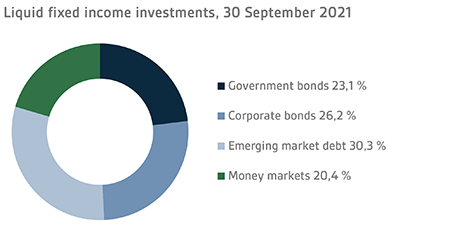
Other fixed income investments
Other fixed income investments include investments in private credit funds and direct lending to companies.
The return on other fixed income investments was 8.6 per cent. Private credit funds returned 9.6 per cent and direct lending 4.8 per cent.
The current year has been quite favourable for private equity funds. The mitigated pandemic situation over the spring and summer has improved business conditions for portfolio companies and the majority of companies affected by Covid-19 have more or less recovered. While the travel industry and retail-related businesses are still struggling, the opening up of economies has also eased their situation. In the current market conditions, special-situation managers in particular have been able to access transactions that offer substantial return potential.
EQUITIES
Listed equities
At the end of the reporting period, the return on listed equities was 16.7 per cent.
Equity returns remained strong at the end of the third quarter, although there was a degree of volatility, especially towards the end of the reporting period. The year got off to a brisk start on the back of positive news, with every month yielding positive returns on VER-held equities up to September. At the beginning of the month uncertainty increased clearly, with September showing clear losses. However, the return on listed equities remained extremely high at close to 17 per cent. The best performance, over 23 per cent, was put in by VER’s investments in the North American stock markets.
The extraordinarily strong sentiment prevailing in the equity market in the first part of the year was clearly eroded in the early autumn due to increased uncertainty. While the uncertainty in the stock market was caused by a number of factors, the global shortage of chips and components caused by the Covid-19 pandemic began to have an increasingly visible impact on companies. Additionally, the marked increase in inflation during the year also gave rise to fears of potential future steps to tighten monetary policy. Equity markets, like other riskier asset classes, have long benefitted from extremely low interest rates as money supply has been abundant, and changes in central bank monetary policy could have a significant impact on equity markets and valuation levels. Aside from these uncertainties, the continued sharp increase in energy prices, among other things, created problems for consumers and companies alike. Towards the end of the reporting period, a slight decline was evident in this year’s earnings forecasts of listed companies, although the forecasts for the coming years remained largely unchanged, at least for the time being. It remains to be seen how the last quarter of the year will shape up amid all the uncertainty, given that equities have been performing very well for many years.
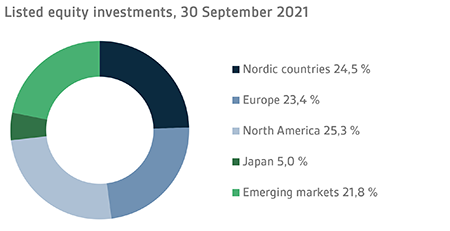
Other equity investments
VER’s other equity investments include investments in private equity funds, non-listed stock and listed real estate investment trusts (REITs).
Private equity investments returned 35.0 per cent, unlisted equities 55.1 per cent and listed real estate investment trusts 13.8 per cent (TWR).
The year has been extremely favourable for private equity funds. With private equity investments, the positive stock market performance, especially in the first half of the year, is reflected in the high valuations of portfolio companies and also in successful exits. At the same time, the impacts of the Covid-19 crisis have remained surprisingly modest, affecting mostly companies engaged in the travel and retail sector. For some sectors, such as healthcare and IT, the crisis has offered opportunities for expansion.
Underlying the hefty returns on unlisted stocks is the positive development of the private equity market. Additionally, a successful exit in spring 2021 contributed substantially to the portfolio’s performance.
Similarly, listed real estate investment trusts benefitted from the robust stock market, although volatility of the market was clearly felt in the third quarter, which resulted in negative returns in September.
OTHER INVESTMENTS
VER’s other investments are investments in real estate, infrastructure, hedge funds and systematic strategies.
The return on unlisted real estate funds was 6.1 per cent while infrastructure investments yielded 11.1 per cent.
The real estate market continued to show a cautiously positive trend. Investor interests in real estate has remained strong, which is reflected in the valuation of residential and logistics properties in particular. Also the transaction market picked up relative to 2020. However, the effects of the Covid-19 crisis are still being felt in the office market and especially in the demand and pricing of shopping centres and commercial premises.
By contrast, the impact on infrastructure investments was largely modest during the year. Returns on basic and digital infrastructure investments developed favourably. Mobility-related businesses are still struggling despite the fact that economies are opening up. The positive performance of equity markets has also underpinned the performance of infrastructure funds to some extent, with the transactions being closed at record high levels.
Hedge funds and systematic strategies gave a 4.5 per cent return in the first three quarters. Of the hedge funds, the best performance was put in by multi-strategy funds as well as funds focusing on the Asian market. Also, quantitative funds yielded healthy returns, even if the dispersion of profits was considerable. With regard to systematic strategies, the biggest contribution was made by emerging market currencies, but for short-term models the third quarter in particular was challenging.
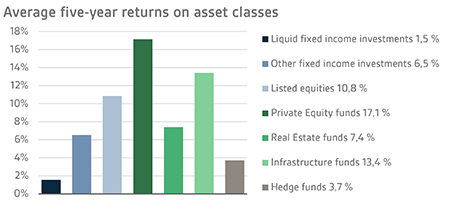
STATE PENSION EXPENDITURE, VER’S TRANSFERS TO THE GOVERNMENT BUDGET, PENSION CONTRIBUTION INCOME AND FUNDING RATIO
The State Pension Fund’s role in balancing government finances has grown and will continue to do so over the next few years. In 2020, the state’s pension expenditure totalled over EUR 4.8 billion while the 2021 budget foresees an expenditure of nearly EUR 4.9 billion. As VER contributes 40 per cent towards these expenses to the government budget, the transfer to the 2021 budget will amount to over EUR 1.9 billion.
By the end of September, VER had transferred EUR 1459 million to the government budget. Over the same period, VER’s pension contribution income totalled EUR 1177 million. The pension contribution income matched the forecast. VER’s net pension contribution income has now turned permanently negative, meaning that clearly more money is transferred from VER to the government budget than VER receives in pension contribution income. This gap between income and budget transfers will continue to grow year on year and slow down the growth of the Fund.
On 31 December 2020, the State’s pension liabilities amounted to EUR 93.1 billion, while the funding ratio was 23 per cent. The Board of Directors of the State Pension Fund of Finland will update its long-term objectives after the reform to the Act on the State Pension Fund currently under preparation.
KEY FIGURES
|
|
|
|
30.9.2021
|
31.12.2020
|
|
Investments, MEUR (market value)
|
22 884
|
20 964
|
|
Fixed income investments
|
8 317
|
7 599
|
|
Equity investments
|
10 929
|
10 994
|
|
Other investments
|
2 564
|
2 280
|
|
Impact of derivatives
|
1 074
|
91
|
|
|
|
|
Breakdown of the investment portfolio
|
|
|
|
Fixed income investments
|
36,3 %
|
36,2 %
|
|
Equity investments
|
47,8 %
|
52,4 %
|
|
Other investments
|
11,2 %
|
10,9 %
|
|
Impact of derivatives
|
4,7 %
|
0,4 %
|
|
|
|
|
1.1.–30.9.2021
|
1.1.–31.12.2020
|
|
Return on investment
|
10,6 %
|
4,0 %
|
|
Fixed income investments
|
|
|
|
Liquid fixed income investments
|
0,9 %
|
2,1 %
|
|
Other fixed income investments
|
8,6 %
|
4,4 %
|
|
Private Credit funds
|
9,6 %
|
3,9 %
|
|
Equity investments
|
|
|
|
Listed equity investments
|
16,7 %
|
6,2 %
|
|
Private Equity investments
|
35,0 %
|
6,6 %
|
|
Unlisted equity investments
|
55,1 %
|
12,2 %
|
|
Other investments
|
|
|
|
Non-listed Real Estate funds
|
6,1 %
|
1,2 %
|
|
Infrastructure funds
|
11,1 %
|
12,2 %
|
|
Hedge funds
|
4,5 %
|
4,9 %
|
|
|
|
|
Pension contribution income, MEUR
|
1 177
|
1 509
|
|
Transfer to state budget, MEUR
|
1 459
|
1 931
|
|
Net contribution income, MEUR
|
-282
|
-423
|
|
Pension liability, BnEUR
|
|
93,1
|
|
Funding ratio, %
|
|
23 %
|
Additional information: Additional information is provided by CEO Timo Löyttyniemi, firstname.lastname@ver.fi, tel. +358 (0)295 201 210
Established in 1990, the State Pension Fund (VER) is an off-budget fund through which the State prepares to finance future pensions and equalise pension expenditure. VER is an investment organisation responsible for investing the State’s pension assets professionally. At the end of September 2021, the market value of the Fund’s investment portfolio stood at EUR 22.9 billion.
All figures presented in this interim report are preliminary and unaudited.